Celebrating Asian American, Native Hawaiian and Pacific Islander Heritage Month
by Cincinnati Art Museum
4/27/2023
In honor of Asian American, Native Hawaiian and Pacific Islander (AANHPI) Heritage Month this May, the Cincinnati Art Museum is continuing to recognize and appreciate the immense role Asian peoples and cultures play in our collection.
The museum is actively collecting and displaying artwork by AANHPI artists across all media. Many of these are light sensitive works, which for their preservation are rotated on and off display.
The museum collection includes more than 73,000 works of art. While not all objects are currently on view in our galleries, you can explore #CAMCollection online to see more works. We frequently add images and update information to increase digital access to the collection.
Ananda Kentish Coomaraswamy (1887–1947)
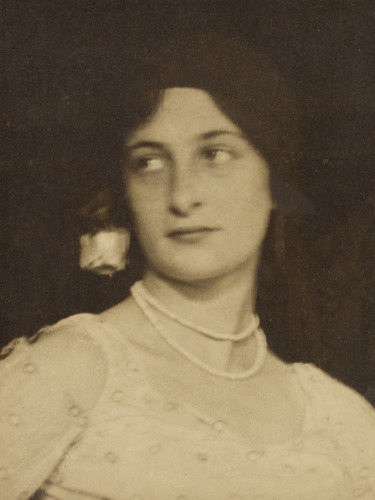
Ananda Kentish Coomaraswamy (British, active United States, b. Sri Lanka, 1877–1947), Stella Bloch, circa 1923, gelatin silver print, Museum Purchase: Carl and Alice Bimel Endowment for Asian Art, 2021.10. This artwork is currently not on view.
Ananda Kentish Coomaraswamy was an art historian and artist who shaped Western understandings of South Asian art through much of the twentieth century. Born in Sri Lanka to an English mother and a Tamil father from an elite family, Coomaraswamy was raised and educated in England before returning to Sri Lanka in 1902 to do fieldwork, and later to head the Geological Survey of Ceylon. He emigrated to the United States in 1917 and became the curator of Indian art at the Museum of Fine Arts, Boston.
In addition to publishing many influential writings on Indian art, metaphysics, and aesthetics, Coomaraswamy also became deeply involved in bohemian and artistic circles in India, Europe, and the United States. Notably, Coomaraswamy informed the work of key American photographer Alfred Stieglitz (1864–1946) and was himself influenced by Stieglitz’s vision of modernism. The dancer Stella Bloch, to whom Coomaraswamy was married in the 1920s, shared Coomaraswamy’s interest in South Asian dance traditions. This tender and monumentalizing portrait of Bloch is one of the small number of Coomaraswamy’s pictures of the dancer known to exist.
Dressing Robe

Dressing Robe, 1874–76, Japan, Meiji period (1868–1912), silk, Gift of Mr. and Mrs. Russell S. Sims in memory of Margaret Minor Shaffer, 1989.13. This artwork is currently not on view.
Although unlabeled, this robe was undoubtedly made in Japan specifically for the Western market. Characterized by a center front opening, high neckline, long sleeves and a slight train, Japanese-made robes such as this were constructed with padding between two layers of silk. Vertically quilted by hand, the collar or lapels, cuffs and patch pockets were often a contrasting color as were the braided cord closures and belts. Hand embroidered with Japonesque designs, they were advertised widely in European and American women’s magazines.
Shiino Shōbei (1839–1900) was a Japanese merchant who exported this type of robe from his establishment in Yokohama. With only a modicum of fit at the waist, this deviation from made-to-measure garments could easily be manufactured in Japan and sold in the West.
Rei Kawakubo (b. 1942)

Rei Kawakubo (Japanese, b. 1942), Jacket, Skirt, and Socks, 2012, polyester, cotton, Museum Purchase: Lawrence Archer Wachs Trust, The Cynthea J. Bogel Collection, 2016.247a-d. This artwork is currently not on view.
Rei Kawakubo has explored both sculptural garments and two-dimensionality throughout her career. This ensemble is lies completely flat when removed from the body, but take on dimensionality on a wearer. Rei Kawakubo’s fall 2012 collection, called The Future’s in Two Dimensions, glorified the flat. Fabricated from polyester felt, this ensemble is a paper doll dress without the tabs—a cartoonish iteration of twenty-first century fashion. Kawakubo is known for her outrageously inventive designs. Her intention each season is not necessarily to make the wearer look “pretty,” but to “do things that have never been done before.”
Bukang Y. Kim (b. 1943)
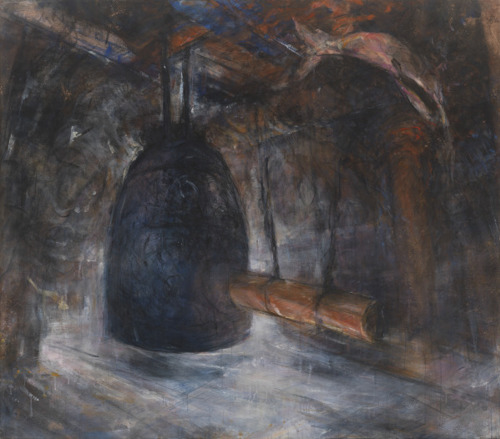
Bukang Y. Kim, (Korean American, b. 1943), The Bell, 1988, acrylic on canvas, 84 x 96 in. (213.4 x 243.8 cm), Gift of Bukang Yu Kim and Dr. Young Ghon Kim, 2019.291. This artwork is currently not on view.

Bukang Y. Kim, (Korean American, b. 1943), Column, 1988, mixed media on canvas, 84 x 66 in. (213.4 x 167.6 cm), Gift of Bukang Yu Kim and Dr. Young Ghon Kim, and family, 2015.140. This artwork is currently not on view.

Bukang Y. Kim, (Korean American, b. 1943), Morning Calm, 1988, mixed media on canvas, 84 x 66 in. (213.4 x 167.6 cm), Gift of Bukang Yu Kim and Dr. Young Ghon Kim, and family, 2015.139. This artwork is currently not on view.
Bukang Kim is a Korean-born American artist based in Cincinnati, Ohio. She received her early training at Seoul National University and after coming to the United States in 1970, furthered her studies at the University of Cincinnati. Kim’s paintings and drawings are widely exhibited in South Korea, Europe, and the United States. In 2014, the Cincinnati Art Museum hosted the special exhibition Bukang Y. Kim: Journey, highlighting Kim’s artistic journey of more than 30 years.
The path Kim has traveled in developing her artistic style is long and inspirational. Her migration to the United States led her to develop a new sensitivity to the arts and cultures of her Korean homeland and helped provide her with a completely new cultural identity, reshaping both her technical and spiritual artistic perspective. Memories from the past, such as the resounding ring of the temple bell in the mountains (Image 1), the ancient wood columns (Image 2), or the paper-mounted sliding doors in the traditional Korean house (Image 3), evoke not only strong emotions associated with Kim’s home country, but also a new interpretation of Asian philosophies and cosmological concepts (such as the Daoist duality of the universe: yin/yang, sound/silence, solid/void, within/without, light/dark) so familiar to her. Kim’s Western-based training, combined with her deep understanding of Asian aesthetics and strong discipline in Asian calligraphy, has helped her create a powerful and distinctive pictorial language all her own.
Woomin Kim (b. 1986)
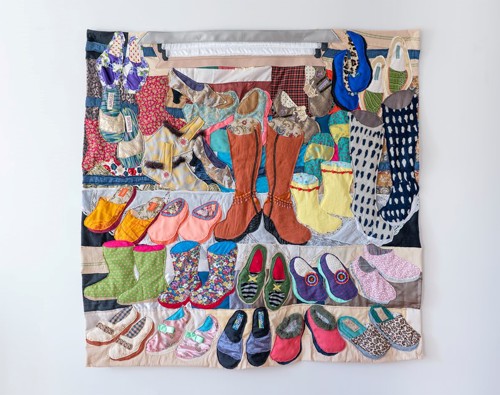
Woomin Kim (South Korean and American, b. 1986), Shijang: Shoe Store II, 2022, fabric, mixed media, Museum Purchase: Mary Light Meyer Charitable Trust, 2023.17. This artwork is currently not on view.
Woomin Kim was born in Busan, Korea in 1986 and now lives and works in Queens, New York. She creates sculptures, installations, and quilts using everyday objects and various found materials. These media include fabrics of all types, glass beads, synthetic fur, fishing net, yarns, textile and clothing labels, and a wide variety of others.
Among her most recent works is the Shijang Project, in which the artist presents a series of vibrant textile collages depicting images of Korean street markets as she remembers them from her past. The English translation of the Korean word shi jang is market.
Speaking about her work in 2021, Kim stated, “This is the place that I used to go all the time growing up. And whenever I visit Korea, it’s one of the first places I go. In my quilts, I describe the different kinds of merchants, stores, and material assemblage that you can see in these kinds of open-air markets. It’s such a vibrant place, with a fish market next to a fabric market and all different kinds of energy.”
Kim’s collage-like quilts are polychromatic extravaganzas that invite viewers into her space and the space of these small market stalls. With objects as specific as dried fish and leopard-print shoes, Kim’s attention to detail, color, and texture results in a massive inventory of items created through an imaginative use of distinctive materials. By incorporating material that may be part of the item she is representing — a mop or pair of shoes—she makes the objects real.
In Shijang: Shoe Store II, she has used different materials and patterns to fashion different kinds of footwear, from boots to sneakers to slippers. There is no sense that any one pair is more desirable than others. This is about necessities rather than high fashion and Kim clearly shows her interest in pattern and color. Her delight in turning a piece of fabric into something as everyday as the pattern inside a boot or a pair of shoes is evident.
Yasuo Kuniyoshi (1893–1953)

Yasuo Kuniyoshi (American, b. Japan, 1893–1953), Daily News, 1935, oil on canvas, The Edwin and Virginia Irwin Memorial, 1959.48. Art © Estate of Yasuo Kuniyoshi, VAGA at Artists Rights Society (ARS), NY. See this artwork in Gallery 212.
In Daily News, a half-dressed woman, smoking a cigarette and supporting her chin with her hand, seems pensive or bored. A man’s fedora hat suggestively appears on the radiator behind her. Always a subtle colorist, Yasuo Kuniyoshi became newly concerned in the late 1930s with the manipulation of paint. The background of swirling brushstrokes and scratches made with the back end of the brush echoes the curlicues of the cast iron stool and the radiator design.
Kuniyoshi was born in Okayama, Japan, and arrived in the United States in 1906. He studied art with Robert Henri (1869–1929) and Kenneth Hayes Miller (1879–1952), who both championed subjects from American life. Kuniyoshi initially went his own way, earning fame in the 1920s for fantasy subjects depicted in a deliberately primitive style. But in his work of the 1930s, he responded to the call for paintings of the “American Scene” with a turn to greater naturalism.
An-My Lê (b. 1960)

An-My Lê, (American, b. Vietnam, 1960), Ship Security, US Navy Hospital Ship Comfort, Haiti, from the series Events Ashore, 2010, printed 2014, Museum Purchase: Carl Jacobs Gift Fund and the Friends of Photography, 2014.28, © An-My Lê. This artwork is currently not on view.
An-My Lê has carefully composed this picture. The ship’s railing divides the sailor from the landscape he surveys. To his left is what appears to be a powerful spotlight; a rifle is mounted to his right. Elements in the composition recede evenly. Two ships, a buoy, and a passing helicopter appear in the middle distance. Further back rises the hilly coastline of Haiti.
Despite his casual pose, the figure in the picture represents a powerful military force. Lê—a political refugee who arrived in the United States at the end of the Vietnam War—has extensively examined America’s military cultures. She has photographed war re-enactors in Virginia and North Carolina, the Marine base in California used to simulate fighting conditions in Iraq, and, in the series that includes this picture, the breadth of non-combat American military deployment across the globe. Taken together, Lê’s photographs outline the many meanings of the phrase “theater of war.”
Listen to a museum staff member discuss Lê’s work in this CAM Look episode posted on May 31, 2021.
Annu Palakannathu Matthew (b. 1964)

Annu Palakunnathu Matthew (Indian, active United States, b. United Kingdom, 1964), Dot/Feather, 2004, inkjet print, from An Indian from India, Portfolio 2, Museum Purchase: Carl and Alice Bimel Endowment for Asian Art, 2019.216.1, © Annu Palakunnathu Matthew. This artwork is currently not on view.
”As an immigrant, I am often questioned about where I am ‘really from.’ When I say that I am Indian, I often have to clarify that I am an Indian from India. Not an AmericanIndian, but rather an IndianAmerican…It seems strange that all this confusion started because Christopher Columbus thought he had found India and called the native people of America collectively as Indians.”
–Annu Palakannathu Matthew, artist statement
Dot/Feather is part of a body of work in which the artist juxtaposes nineteenth- and early twentieth-century photographs with carefully composed images of herself. Using costumes, props, and post-exposure digital manipulation, Matthew creates self-portraits that play with cultural identity. In doing so, she underscores problematic representations of people in archival images and portrays the complexities of the diasporic experience.
Nam June Paik (1932–2006)
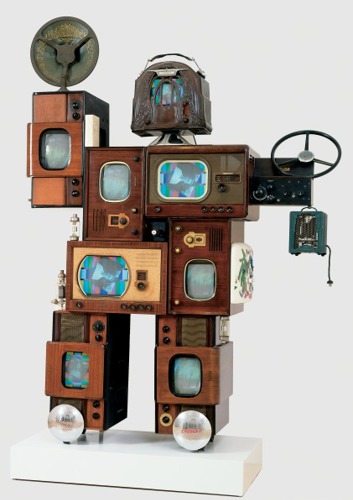
Powel Crosley, Jr., Nam June Paik (American, b. Korea, 1932–2006), artist, 1992, wood, plastic, paint, glass, custom electronics, parts from a variety of Crosley products that date from the 1920s through the early 1950s, eight CRT televisions, two DVD players, video, John J. Emery Endowment and The Edwin and Virginia Irwin Memorial, © Nam June Paik Estate, 1992.140. This artwork is currently not on view.
When approached by the Cincinnati Art Museum to create a piece specific to Cincinnati, Nam June Paik suggested a video sculpture to honor Powel Crosley, Jr., the Cincinnati inventor, and entrepreneur. At that time, Paik, who exhibited internationally, assembled all his sculptures, including Powel Crosley, Jr., in a warehouse in the Cincinnati neighborhood of Over-the-Rhine.
The work consists of various Crosley products: TV and radio cabinets, car hubcaps and handles, radios, freezer doors, and radio transmission tubes. The boxy-looking “portrait” is related to a family of human-looking robots that Paik created in 1986. In the Crosley sculpture, he used eight television monitors to project two different programs. These programs loop clips from a television profile of Crosley that Paik intercut with popular imagery, which flash on the screens at a hypnotizing pace. In contrasting the antiquated Crosley parts with contemporary digital media, Paik made an oblique comment on technological evolution.
Crosley was born in Cincinnati in 1886. After working first in advertising and auto-building, he brought the new technology of radio to millions through build-it-yourself kits. Crosley also founded radio station WLW and public television WCET, made the first car radio, built the first compact car, and owned the Cincinnati Reds baseball team.
Paik, born in Korea, studied music and art history in Tokyo. In 1958 he met the composer John Cage, who became a lasting influence. In the 1960s, Paik became fascinated with television and video. He exploited the medium to assert his belief that the human spirit is ascendant over technology.
Listen to a museum volunteer discuss Paik’s work in this CAM Look episode posted on October 28, 2020.
Palampore
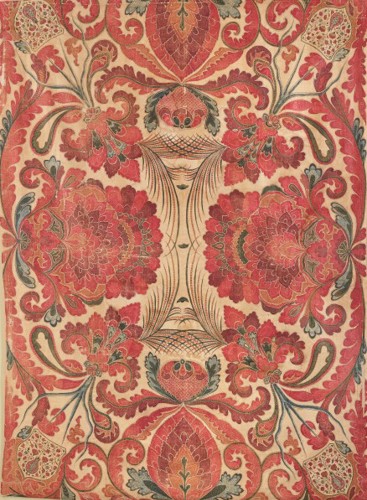
Palampore, 1700–50, India, hand painted mordant and resist dyed cotton, Museum Purchase: Carl and Alice Bimel Endowment for Asian Art, 2019.188. This artwork is currently not on view.
From the seventeenth to the nineteenth century, India was a dominant exporter of finely woven cloth, with the country’s textiles reaching every major market around the globe. Indian textiles widely appealed to Persian, Armenian, Indonesian, Japanese, and European markets for their delicacy in weave, brilliant color palettes, and richness in design and pattern. The palampore displayed here, with its large palmettes and intertwining floral motifs in reds, blues, green, and yellow, was likely created for the Dutch market.
The Coromandel Coast was a leading center for cotton manufacture. Hand-woven, painted, and dyed textiles from this southeastern coastal region of India were used to fashion dress, as well as to furnish the homes of the European elite. Along with other finely woven textiles, palampores (a type of chintz often used as bedspreads and in fashionable dress), were highly prized portable symbols of wealth and prestige and were also part of a complex political and social system of gift exchange.
Shahzia Sikander (b. 1959)
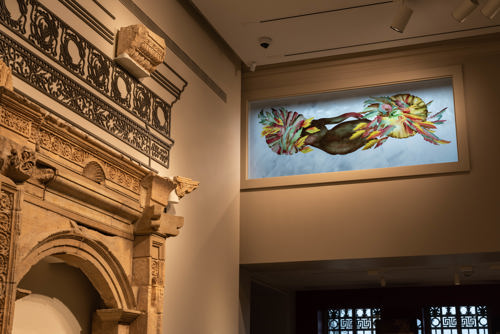
Shahzia Sikander (Pakistani and American, b.1969), Caesura, 2021, painted and laminated glass, Alice Bimel Endowment for Asian Art, 2021.97a–k. See this artwork in Gallery 147.
Look up in Gallery 147, showcasing the museum’s ancient Nabataean collection, and you will notice a monumental artwork occupying the clerestory windows across both sides of this gallery. Commissioned by the museum and inspired by the objects on view, Caesura creates dynamic connections between past and present. Shahzia Sikander is known for innovative works that engage playfully with scale, religion, culture, histories, and images of power. While Sikander’s own identity connects with Pakistan rather than the countries of the modern Middle East, her practice mines cultural influences and forms that play across this vast region.
Sikander’s thoughtful response to the museum’s collection of Nabataean stone sculptures unites the ancient world with contemporary practices in visually imaginative and awe-inspiring ways. Incorporating a contemporary commission into these galleries of ancient art encourages multiple ways of seeing, reading, and understanding cultures—just as Sikander’s layered work suggests movement, color, density, gesture, and ever-shifting light.
Listen to a museum staff member discuss Sikander’s work in this CAM Look episode posted on November 3, 2021.
Esther Shimazu (b. 1957)

Leaping Tabby, 2002, Esther Shimazu (American, born 1957), stoneware, The Nancy and David Wolf Collection, 2011.139 © Esther Shimazu. See this artwork in Gallery 222.
The nude, bald figures created by Esther Shimazu, a third-generation JapaneseAmerican, are meant to encapsulate the state of unselfconsciousness—the attitude of being care and judgementfree. Shimazu often pairs her people with animals, like this leaping housecat, that embody her ideas about freedom and defiance.
Kataro Shirayamadani (1865–1948)

Vase, 1900, The Rookwood Pottery Company (American, est. 1880), Kitaro Shirayamadani (American, b. Japan, 1865–1948), decorator, stoneware, Black Iris glaze line with copper and silver electrodeposits, Museum Purchase: Lawrence Archer Wachs Fund and a generous gift from Judge and Mrs. Norman A. Murdock, 2004.68. See this artwork in Gallery 114.
In 1895, the Rookwood Pottery Company began experiments to achieve the challenging technical feat of using the color black in its glazes. The experiments succeeded, and in 1899 Rookwood launched the “Black Iris” glaze line, featuring natural-colored designs, usually flora, on black backgrounds.
Japanese-born Kitaro Shirayamadani, Rookwood’s most accomplished artist, designed and created this masterpiece in the pottery’s new line. It features birds flying above masterfully carved silver and copper water lilies, all against a black night sky. The complex technique of adding metallic decoration to clay via electrodeposit had been developed by Shirayamadani earlier that year, but Rookwood soon discontinued its application due to high production costs.
This vasewas almost certainly displayed at the Exposition Universelle of 1900 in Paris, where Rookwood received a Grand Prize, the fair’s highest honor.
Listen to a museum staff member discuss Shirayamadani’s work in this CAM Look episode posted on April 20, 2022.
Xia Zhang (b. 1989)
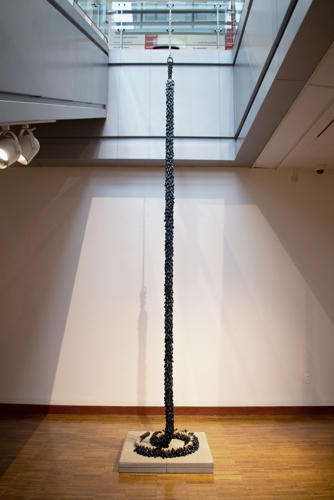
Black and Blue BS Theory, 2020, Xia Zhang (Chinese American, b.1989), ceramic, metal, gym rope, thread, concrete, Courtesy of the artist. © Xia Zhang. Photography by Xia Zhang. See this artwork in Gallery 222.
Here, multidisciplinary artist and University of Cincinnati professor Xia Zhang examines the notion of “pulling yourself up by your bootstraps,” a phrase often used in American political speeches, social criticism, and pep talks to suggest you can better yourself without outside help. Zhang often cites process as her primary artistic medium, since repetition in making is essential to realizing the ideas and emotionality behind her work. For this piece, Zhang crafted hundreds of clay forms inspired by moon drop grapes, a black and blue genetically modified luxury fruit. Together, these forms climb up a gym rope, symbolizing the disadvantaged laboring bodies that nurtured and harvested the grapes in an often-fruitless attempt to access a better life. “Pulling yourself up by your bootstraps” is a privilege and a romanticized view of individual labor that overlooks the essential knowledge and resources one must have to navigate America’s systems and structures for “success” and sustainability.
Explore more works by AANHPI artists with this self-guided tour through our galleries and online collection.






